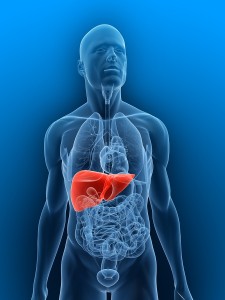Introduction
First of all, hepatitis means inflammation of the liver. While alcohol can cause this inflammation (alcoholic hepatitis), so can drugs (drug induced hepatitis) or viruses (hepatitis A ,B, C etc.). In contrast, another chapter deals with viral hepatitis.
Symptoms
Depending on what the immune system of the patient is like, hepatitis presents in very different ways.
For the most part, a person with good immunity might only experience a flu like illness that lasts for a few days. There will be a lack of appetite, but only very little bloating or abdominal discomfort. In contrast, another patient might suddenly be very ill with a violent distaste for cigarettes, even though the patient might have been a heavy smoker before. Nausea, vomiting and a fever will follow. After several days to a week the urine turns dark and the patient looks jaundiced. In the second week the patient may feel better, although the jaundice is still worsening. The physician feels an enlarged tender liver with a smooth edge. In due time (typically within 3 to 4 weeks from the beginning) most patients recover.
Blood tests to monitor clinical course
Blood tests help in determining the severity and the type of virus. The higher the liver enzymes, the worse the liver damage. Of the various subtypes hepatitis A and E do not tend to get chronic. But hepatitis B, C, D and G lead to a chronic hepatitis and cirrhosis. In the long run cirrhosis of the liver can turn into liver cancer after 10 years or more. It is common knowledge that liver cancer is a complication of hepatitis B, C and D.
For more detailed info on hepatitis follow this link.
References
1. DM Thompson: The 46th Annual St. Paul’s Hospital CME Conference for Primary Physicians, Nov. 14-17, 2000, Vancouver/B.C./Canada
2. C Ritenbaugh Curr Oncol Rep 2000 May 2(3): 225-233.
3. PA Totten et al. J Infect Dis 2001 Jan 183(2): 269-276.
4. M Ohkawa et al. Br J Urol 1993 Dec 72(6):918-921.
5. Textbook of Primary Care Medicine, 3rd ed., Copyright © 2001 Mosby, Inc., pages 976-983: “Chapter 107 – Acute Abdomen and Common Surgical Abdominal Problems”.
6. Marx: Rosen’s Emergency Medicine: Concepts and Clinical Practice, 5th ed., Copyright © 2002 Mosby, Inc. , p. 185:”Abdominal pain”.
7. Feldman: Sleisenger & Fordtran’s Gastrointestinal and Liver Disease, 7th ed., Copyright © 2002 Elsevier, p. 71: “Chapter 4 – Abdominal Pain, Including the Acute Abdomen”.
8. Ferri: Ferri’s Clinical Advisor: Instant Diagnosis and Treatment, 2004 ed., Copyright © 2004 Mosby, Inc.







